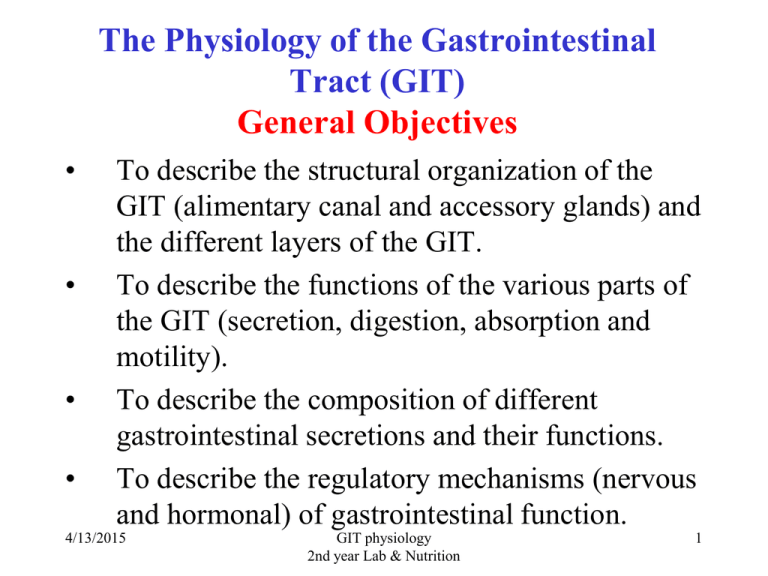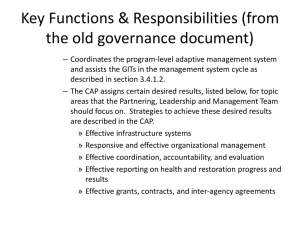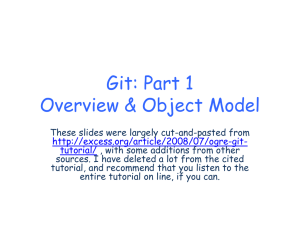
The Physiology of the Gastrointestinal
Tract (GIT)
General Objectives
•
•
•
•
To describe the structural organization of the
GIT (alimentary canal and accessory glands) and
the different layers of the GIT.
To describe the functions of the various parts of
the GIT (secretion, digestion, absorption and
motility).
To describe the composition of different
gastrointestinal secretions and their functions.
To describe the regulatory mechanisms (nervous
and hormonal) of gastrointestinal function.
4/13/2015
GIT physiology
2nd year Lab & Nutrition
1
I- Introduction to GIT Physiology
Learning Objectives
• Describe the general functions of the GIT.
• Describe the general organization of the GIT.
• Describe the common layers of the digestive tract
wall.
• Describe the nervous and hormonal regulation of
GI function.
• Describe the different movements of the GIT.
4/13/2015
GIT physiology
2nd year Lab & Nutrition
2
Functions of the GIT
•
•
•
•
•
•
Ingestion
Motility: mixing and propulsion
Secretion
Digestion
Absorption
Excretion
4/13/2015
GIT physiology
2nd year Lab & Nutrition
3
Organization of the GIT
• The alimentary canal: mouth, pharynx,
esophagus, stomach, small intestine, large
intestine, rectum and anal canal.
• Associated glands: salivary glands,
pancreas, liver and gall bladder.
4/13/2015
GIT physiology
2nd year Lab & Nutrition
4
4/13/2015
5
Layers of digestive tract wall
•
•
•
•
Mucosa
Submucosa
Muscularis externa
Serosa
4/13/2015
GIT physiology
2nd year Lab & Nutrition
6
4/13/2015
GIT physiology
2nd year Lab & Nutrition
7
4/13/2015
GIT physiology
2nd year Lab & Nutrition
8
Mucosa
• This layer is concerned with secretion of
both the digestive juices and certain
hormones as well as the absorption of the
various nutrients.
• It contains blood capillaries, lymph vessels
and a layer of smooth muscle called the
muscularis mucosa.
4/13/2015
GIT physiology
2nd year Lab & Nutrition
9
Submucosa
•
This is a dense connective tissue layer that
contains larger blood and lymph vessels as
well as a network of neurons called
submucous or Meissner’s plexus.
4/13/2015
GIT physiology
2nd year Lab & Nutrition
10
• Muscularis externa: an outer longitudinal
layer and inner circular layer of smooth
muscle. In between myenteric or Aurbach’s
plexus.
• Serosa: an outer fibrous coating
4/13/2015
GIT physiology
2nd year Lab & Nutrition
11
Control of GI functions
(secretions and motility)
• Nervous
• Hormonal
4/13/2015
GIT physiology
2nd year Lab & Nutrition
12
Nervous supply to the Gut
Extrinsic
(autonomic)
Intrinsic
• Sympathetic (decreases • Submucous or Meissner’s
motor and secretory
plexus (controls secretory
activity, contraction of
function)
sphincters)
• myenteric or Auerbach’s
• Parasympathetic
plexus (controls motor
(stimulatory)
activity)
4/13/2015
GIT physiology
2nd year Lab & Nutrition
13
Hormonal control of GIT function
1. Gastrin (from the stomach): stimulates
gastric motility and secretion.
2. CCK (from small intestines) stimulates
pancreatic enzyme secretion, and gall
bladder contraction. Inhibits gastric
emptying.
3. Secretin (from small intestines): stimulates
pancreatic and biliary bicarbonate secretion.
4/13/2015
GIT physiology
2nd year Lab & Nutrition
14
Types of movements in the GIT
• Propulsive: move bolus forward.
• Segmentation: mixing in the small intestine.
4/13/2015
GIT physiology
2nd year Lab & Nutrition
15
II- Mouth, Salivary glands & Esophagus
Learning Objectives
• Name the salivary glands.
• Describe the salivary secretion: volume, pH
•
•
•
•
and composition.
Describe the different functions of saliva.
Describe the regulation of salivary secretions.
Name functions of esophagus.
Describe the mechanism of swallowing.
4/13/2015
GIT physiology
2nd year Lab & Nutrition
16
The Salivary glands
• 3 paired salivary glands made of ducts and
acini that make between 1-1.5 liters/day
with a pH of 6-7
• Parotid glands
• Submandibular or submaxillary glands
• Sublingual glands
4/13/2015
GIT physiology
2nd year Lab & Nutrition
17
4/13/2015
GIT physiology
2nd year Lab & Nutrition
18
Composition of Saliva
• Mostly water 99.5%
• Ionic content: low in Na+ and Cl-, high in
K+ and HCO3• Enzymes: lingual lipase and -amylase
(ptyalin).
• Mucins
• Lysozymes: proteolytic enzyme
• Immunoglobulin A (IgA)
4/13/2015
GIT physiology
2nd year Lab & Nutrition
19
Functions of saliva
•
Digestive functions:
•
•
Amylase breaks down starch, and lingual lipase breaks down
triglycerides (active in the stomach).
It dissolves food materials so it can be sensed by taste buds.
•
Lubrication:
•
•
Keeps mouth moist and thus facilitates movements of lips and
tongue during speech.
Moistens food and thus facilitates swallowing.
•
Protection:
•
Keeps mouth and teeth clean by dissolving and washing food
particles from between the teeth.
Has an anti-bacterial action.
Buffers acidic gastric secretions.
•
•
4/13/2015
GIT physiology
2nd year Lab & Nutrition
20
Regulation of Salivary secretion
A) Simple or unconditioned: The presence of food in
the mouth results in reflex secretion of saliva.
•
Stimulus: presence of food in the mouth.
•
Receptors: taste buds.
•
Afferent: nerves from taste buds carry impulses
to salivary centre.
•
Centre: salivary centre in medulla oblongata
(in brain stem).
•
Efferent: autonomic nerves supplying salivary
glands.
4/13/2015
GIT physiology
2nd year Lab & Nutrition
21
B) Conditioned
•
•
•
An acquired reflex and needs training.
The centre is in the cerebral cortex.
The sight, smell, thought of food in the
absence of food in the mouth increase
salivary secretion.
4/13/2015
GIT physiology
2nd year Lab & Nutrition
22
• Salivary secretions are regulated by nervous
mechanisms only
• Parasympathetic stimulation, produces flow
of watery saliva that is rich in enzymes.
• Sympathetic stimulation produces a much
smaller volume of thick saliva that is rich in
mucus.
4/13/2015
GIT physiology
2nd year Lab & Nutrition
23
4/13/2015
GIT physiology
2nd year Lab & Nutrition
24
Esophagus
• Function:
– swallowing or deglutition, which is the process
of moving food from the mouth through the
esophagus into the stomach
– No digestion or absorption
– Secretions: mucus
4/13/2015
GIT physiology
2nd year Lab & Nutrition
25
4/13/2015
GIT physiology
2nd year Lab & Nutrition
26
Swallowing
• Swallowing can be initiated voluntarily but
then it is under reflex control.
Swallowing reflex:
• Receptors: touch receptors in pharynx.
• Afferent: sensory impulses from receptors.
• Centre: swallowing centre in brain stem.
• Efferent: parasympathetic nerves to muscles
of pharynx and esophagus.
4/13/2015
GIT physiology
2nd year Lab & Nutrition
27
Mechanism of Swallowing
• 3 stages:
– Oral or Voluntary: bolus of food is passed into the
pharynx by upward and backward movement of tongue
against palate. This stimulates the touch receptors that
initiate the swallowing reflex.
– Pharyngeal: involuntary passage of bolus through the
pharynx into esophagus. Respiratory passageways are
closed & respiration is inhibited (protective reflexes).
– Esophageal: involuntary passage of bolus from
esophagus to stomach by peristaltic movements of
esophagus.
4/13/2015
GIT physiology
2nd year Lab & Nutrition
28
Protective reflexes during pharyngeal phase
of swallowing:
a) Elevation of the soft palate: closes posterior nasal
openings, thus preventing food reflux into the nasal
cavities.
b) Elevation of the larynx against the epiglottis: closes the
superior laryngeal orifice (glottis), thus preventing food
entrance into the trachea.
c) Approximation of the vocal cords: This also closes the
glottis, but its role is much more important than that of the
epiglottis.
d) Temporary apnea: stoppage of breathing for few seconds
which also prevents food entrance into the trachea.
4/13/2015
GIT physiology
2nd year Lab & Nutrition
29
4/13/2015
GIT physiology
2nd year Lab & Nutrition
30
4/13/2015
GIT physiology
2nd year Lab & Nutrition
31
4/13/2015
GIT physiology
2nd year Lab & Nutrition
32
III- The Stomach
Learning Objectives
•
•
•
•
Describe the gross anatomy and histology of the
stomach.
Describe the different functions of the stomach.
Describe the composition of gastric secretion
and the function of each constituent.
Describe the different mechanisms that regulate
gastric secretions.
4/13/2015
GIT physiology
2nd year Lab & Nutrition
33
4/13/2015
34
4/13/2015
GIT physiology
2nd year Lab & Nutrition
35
4/13/2015
36
Stomach
Functions of the stomach:
– Motor:
• Storage
• Mixing
• Emptying
– Secretory:
• Exocrine (HCL, mucus, intrinsic factor, pepsinogen)
• Endocrine (Gastrin)
– Digestive (proteins and lipids)
– Absorption: water, ions, alcohol and aspirin
4/13/2015
GIT physiology
2nd year Lab & Nutrition
37
Gastric secretion
• 3 L/day, highly acidic (pH 1-2).
• Composition and function:
Mucus (from mucus cells): protection
Enzymes (from chief cells): pepsin, lipase:
digestion.
Intrinsic factor & HCL (from parital cells):
Intrinsic factor is important for vit B12
absorption from small intestine.
4/13/2015
GIT physiology
2nd year Lab & Nutrition
38
4/13/2015
GIT physiology
2nd year Lab & Nutrition
39
Functions of HCL
• Kills ingested bacteria.
• Aids protein digestion (activates pepsinogen
into pepsin).
• Provides the optimum pH for pepsin action.
• Stimulates the secretion of hormones that
promote the flow of bile and pancreatic
juice.
4/13/2015
GIT physiology
2nd year Lab & Nutrition
40
Regulation of Gastric secretion
3 phases:
• Cephalic
• Gastric
• Intestinal
4/13/2015
GIT physiology
2nd year Lab & Nutrition
41
Cephalic phase (nervous)
•
•
•
•
•
•
Conditioned:
stimulus: smell, sight, thought of food
centre: brain
efferent: along vagus nerve
Unconditioned:
stimulus: taste of food
centre: medulla oblongata
efferent: along vagus nerve
4/13/2015
GIT physiology
2nd year Lab & Nutrition
42
Gastric phase
Stimulus: food distending stomach
• Nervous: through vagus: continued gastric
secretion and motility.
• Hormonal: (Gastrin) produces secretion rich
in acid and pepsinogen
4/13/2015
GIT physiology
2nd year Lab & Nutrition
43
Intestinal phase
Stimulus: food distending duodenum.
• Nervous: inhibits gastric secretion and
motility.
• Hormonal: (secretin and CCK) inhibits
gastrin release, gastric secretion and
motility.
4/13/2015
GIT physiology
2nd year Lab & Nutrition
44
4/13/2015
GIT physiology
2nd year Lab & Nutrition
45
IV- Exocrine Pancreas
Learning Objectives
• Describe the composition and function of
pancreatic secretions.
• Describe the hormonal and nervous
regulation of pancreatic secretion.
4/13/2015
GIT physiology
2nd year Lab & Nutrition
46
4/13/2015
GIT physiology
2nd year Lab & Nutrition
47
Composition and function of pancreatic
secretion
• 1.5 L/day, alkaline (pH 8)
• Composition and function:
– Digestive enzymes: peptidases (trypsin and
chymotrypsin), lipases, and amylase.
– Water
– HCO3-:
• neutralize the gastric acid
• Provides optimum medium for action of pancreatic
enzymes.
4/13/2015
GIT physiology
2nd year Lab & Nutrition
48
Regulation of pancreatic
secretion
Mainly hormonal:
• Secretin: acid chyme in duodenum stimulates
secretions rich in water and HCO3- but poor in
enzymes
• CCK: digestive products of proteins and fat in
duodenum stimulates secretions of pancreatic juice
rich in enzymes.
Both hormones are secreted by upper intestinal cells.
4/13/2015
GIT physiology
2nd year Lab & Nutrition
49
4/13/2015
GIT physiology
2nd year Lab & Nutrition
50
Nervous control of pancreatic
secretion
• Parasympathetic impulses along vagus
nerves stimulate secretion of pancreatic
enzymes.
4/13/2015
GIT physiology
2nd year Lab & Nutrition
51
V- The Biliary System
Learning Objectives
•
•
•
•
List the different functions of the liver.
Describe the composition of bile and its functions.
Describe the functions of bile salts.
Describe the different functions of the gall
bladder.
• Describe the different mechanisms that regulate
bile secretion & gall bladder emptying.
• Describe the types of jaundice according to the
cause.
4/13/2015
GIT physiology
2nd year Lab & Nutrition
52
The biliary system includes:
• The liver
• The gall bladder
• Associated ducts:
– Hepatic ducts (right, left and common)
– Cystic duct
– Common bile duct
4/13/2015
GIT physiology
2nd year Lab & Nutrition
53
4/13/2015
GIT physiology
2nd year Lab & Nutrition
54
Functions of liver
• Synthesis & Secretion of bile.
• Metabolic processes (e.g. gluconeogenesis,
glycogenolysis).
• Detoxification and degradation (e.g. drugs and hormones).
• Synthesis of plasma proteins (e.g. albumin and clotting
factors).
• Storage (e.g. iron and Vit B12).
• Activation of vitamin D.
• Removal of bacteria and old RBC.
• Excretion of cholesterol and bilirubin.
4/13/2015
GIT physiology
2nd year Lab & Nutrition
55
Bile secretion
• Bile is secreted by hepatocytes.
• About 500 ml (250-1200ml) is secreted per
day.
• pH 8
• Enters duodenum during digestion of meals.
• Stored in gall bladder and concentrated
between meals.
4/13/2015
GIT physiology
2nd year Lab & Nutrition
56
Composition of human bile (gm/dl)
Hepatic
Gall bladder
Water
98%
89%
Bile salts
1.1
6
Bilirubin
0.04
0.3
Cholesterol
0.1
0.3-0.9
Fatty acids
0.12
0.3-1.2
Lecithin
0.04
0.3
4/13/2015
GIT physiology
2nd year Lab & Nutrition
57
Electrolyte content of bile (mmol/L)
Hepatic
Gall bladder
Na+
145
130
+
5
12
5
23
Cl
100
25
HCO3-
28
10
pH
8.3
7.3
4/13/2015
GIT physiology
2nd year Lab & Nutrition
K
Ca
2+
-
58
Functions of bile
• Bile salts play an important role in fat
digestion and absorption.
• Excretion of waste products (e.g. bilirubin).
• Bicarbonate in bile neutralizes acid in
duodenum.
4/13/2015
GIT physiology
2nd year Lab & Nutrition
59
Bile salts
•
•
•
•
Most important component of the bile.
They are Na+ and K + salts of bile acids.
They are derivatives of cholesterol.
Recycled through the enterohepatic
circulation.
4/13/2015
GIT physiology
2nd year Lab & Nutrition
60
4/13/2015
GIT physiology
2nd year Lab & Nutrition
61
Function of bile salts
• Emulsify large fat particles into smaller
ones that can be attacked by lipase
(detergent action).
• Help in the transport and absorption of fat
(micellar formation).
4/13/2015
GIT physiology
2nd year Lab & Nutrition
62
4/13/2015
GIT physiology
2nd year Lab & Nutrition
63
4/13/2015
GIT physiology
2nd year Lab & Nutrition
64
• Prevent precipitation of cholesterol by
keeping them in solution (prevent gall
stones).
• Stimulate bile secretion by liver cells.
4/13/2015
GIT physiology
2nd year Lab & Nutrition
65
Gall Bladder
•
•
•
•
•
No digestive role.
Stores bile.
Concentrates bile.
Empties during meals.
Secretes mucus.
4/13/2015
GIT physiology
2nd year Lab & Nutrition
66
Regulation of bile secretion and gall
bladder emptying
• Chemical:
– Bile salts: most important stimulant of bile
secretion by liver cells.
• Hormonal:
– Secretin: secreted in response to acid chyme,
causes secretion of bile rich in water and HCO3– CCK: secreted in response to fatty acids in
duodenum, causes gall bladder to contract and
sphincter of Oddi to relax.
4/13/2015
GIT physiology
2nd year Lab & Nutrition
67
4/13/2015
GIT physiology
2nd year Lab & Nutrition
68
• Neural
– Vagal stimulation:
• Increases bile secretion
• Weak contraction of gall bladder
4/13/2015
GIT physiology
2nd year Lab & Nutrition
69
Jaundice
• Jaundice: yellowish discoloration of the
skin, sclera & mucous membranes due to a
blood bilirubin level.
Causes:
• Pre-hepatic: due to excess production of
bilirubin e.g. haemolytic anaemia.
• Hepatic: liver disease e.g. hepatitis
• Post-hepatic: obstruction to bile flow e.g.
gall stones.
4/13/2015
GIT physiology
2nd year Lab & Nutrition
70
VI- Small & Large Intestines
Learning Objectives
•
•
•
•
•
•
Describe the intestinal juice (volume, pH,
composition, function and its regulation).
Name the different digestive enzymes and their
substrates.
Describe the reabsorptive processes of different
substances.
Describe the different intestinal movements
(motility).
Describe the different functions of the colon.
Describe the defecation reflex and its regulation.
4/13/2015
GIT physiology
2nd year Lab & Nutrition
71
Small intestine
Structure
• Long tube (about 6m) extending from
pyloric sphincter in stomach and joins large
intestine at the ileocecal sphincter
• duodenum (20 cm), jejunum (2.5 m) and
ileum (3.5 m).
• Surface area greatly increased by intestinal
mucosal foldings, villi and microvilli.
• Structure of a villus (see figure).
4/13/2015
GIT physiology
2nd year Lab & Nutrition
72
73
4/13/2015
GIT physiology
2nd year Lab & Nutrition
74
4/13/2015
GIT physiology
2nd year Lab & Nutrition
75
4/13/2015
GIT physiology
2nd year Lab & Nutrition
76
Small intestine
Function
• Digestion : Enzymes are intracellular
(Disaccharidases and aminopeptidases).
• Absorption: completed in s. intestine, large
surface area (as large as a tennis court area).
(Site where most digestion and absorption
take place).
• Secretion
• Motility
4/13/2015
GIT physiology
2nd year Lab & Nutrition
77
Digestion
4/13/2015
GIT physiology
2nd year Lab & Nutrition
78
4/13/2015
GIT physiology
2nd year Lab & Nutrition
79
4/13/2015
GIT physiology
2nd year Lab & Nutrition
80
4/13/2015
GIT physiology
2nd year Lab & Nutrition
81
4/13/2015
GIT physiology
2nd year Lab & Nutrition
82
Absorption
4/13/2015
GIT physiology
2nd year Lab & Nutrition
83
4/13/2015
GIT physiology
2nd year Lab & Nutrition
84
4/13/2015
GIT physiology
2nd year Lab & Nutrition
85
Exocrine intestinal secretions
• Intestinal juice: alkaline fluid (water and
electrolytes) with few enzymes from
desquamated cells (1000-1500 ml/day).
• HCO3-: neutralize acid.
• Mucus: protection and lubrication.
• No digestive enzymes.
4/13/2015
GIT physiology
2nd year Lab & Nutrition
86
Regulation of intestinal secretion
Local: mechanical stimulation of intestinal
mucosa by the presence of chyme.
Nervous: vagal nerve stimulation causes
secretion of intestinal glands.
Hormonal: ? secretin
4/13/2015
GIT physiology
2nd year Lab & Nutrition
87
Intestinal motility
• Segmentation: ring-like contractions. Mix
chyme and expose it to absorptive surface.
• Peristaltic: a wave of contraction preceded
by relaxation. Propels the gastrointestinal
contents toward the large intestine.
4/13/2015
GIT physiology
2nd year Lab & Nutrition
88
4/13/2015
GIT physiology
2nd year Lab & Nutrition
89
4/13/2015
GIT physiology
2nd year Lab & Nutrition
90
Large Intestine
4/13/2015
GIT physiology
2nd year Lab & Nutrition
91
4/13/2015
GIT physiology
2nd year Lab & Nutrition
92
Large intestine
• No digestive function.
• Absorption of water, Na+ and other
minerals.
• Secretion of mucus for lubrication.
• Storage of feces (undigested food).
• Bacteria in colon synthesize vitamin K and
a number of B complex vitamins.
4/13/2015
GIT physiology
2nd year Lab & Nutrition
93
Defecation reflex
•
•
•
•
•
Stimulus: undigested material distending rectum.
Receptor: stretch receptor in rectum.
Afferent: sensory to sacral segment of spinal cord
Centre: sacral segment of spinal cord
Efferent: parasympathetic nerves to smooth
muscle of rectum and internal anal sphincter.
• External anal sphincter is under voluntary control.
4/13/2015
GIT physiology
2nd year Lab & Nutrition
94
Defecation reflex
• Causes the internal anal sphincter to relax
and the rectum and sigmoid colon to
contract.
• If external anal sphincter is relaxed
defecation occurs.
• Defecation can be inhibited by voluntary
tightening of external anal sphincter.
4/13/2015
GIT physiology
2nd year Lab & Nutrition
95
4/13/2015
GIT physiology
2nd year Lab & Nutrition
96










